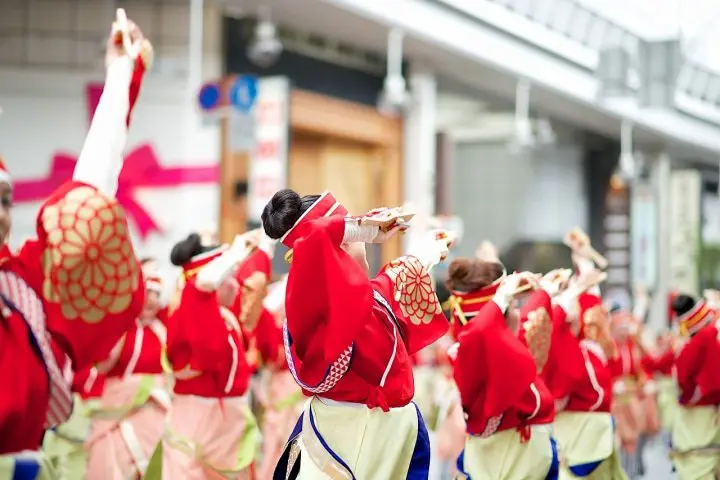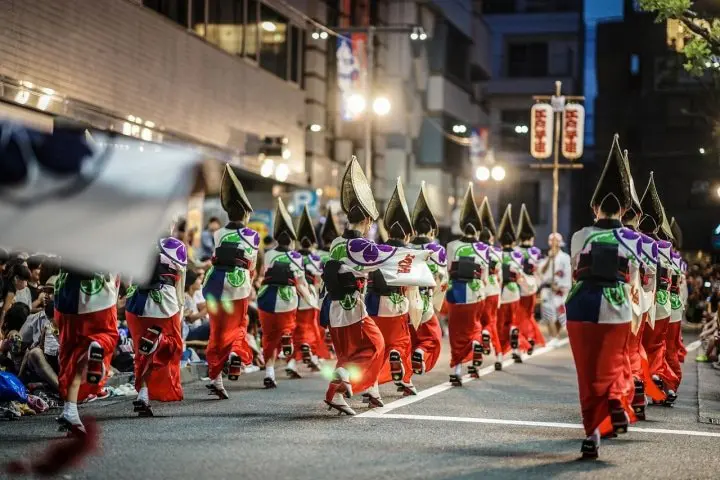4 Festivals to Attend When Visiting the Chugoku and Shikoku Region

There are many attractive festivals in the Chugoku and Shikoku regions. Most notable festivities include the Kangensai, Yosakoi Festival, Awa Odori, and the Niihama Taiko Festival. This article will introduce these unique festivals that will have you celebrating in the streets.
There are countless festivals in the Chugoku and Shikoku region. For example, there is a classic festival where you can listen to traditional music at a World Heritage shrine and a lively one where you can dance around the city. This article will introduce some well-known festivals in the Chugoku and Shikoku areas.
1. Hatsukaichi City, Hiroshima: Kangensai Festival

©Hiroshima Prefecture / ©JNTO
This festival is held annually in early August at the World Heritage site Istukushima Shrine in Hatsukaichi City, Hiroshima Prefecture. Miyajima is a majestic, sacred island sometimes called the "Mont Saint-Michel of Japan." Likewise, the Kangensai Festival is full of spirituality and mystique.
"Kangen" means "wind and string instruments." True to its name, the performances showcase traditional Japanese wind and string instruments.
The Kangensai Festival is said to have been started by Taira no Kiyomori, a military leader in the 12th century. During that time, it was popular among nobles to float boats on the water and play instruments, including the flute and koto (a plucked string instrument).
The beautiful sound of wind and string instruments reverberating around the island creates a dreamy experience for participants. The entrance fee to Itsukushima Shrine is 300 yen for adults, 200 yen for high school students, and 100 yen for elementary and middle school students. Miyajima is a five-minute walk from JR Miyajimaguchi Station.
Event Information
Address: Hiroshima, Hatsukaichi City, Miyajimacho 1162-18
Website: Kangensai
2. Kochi City, Kochi: Yosakoi Matsuri

Photo by Pixta
This festival is held yearly in Kochi City, Kochi Prefecture from August 9 to the 12th. It is ranked among the three Great Yosakoi Festivals in the Shikoku region along with the Awa Odori in Tokushima Prefecture and the Niihama Taiko Festival in Ehime Prefecture.
It is also the original home of the Yosakoi Festival that has come to be held across Japan. Moreover, it is one of the top three Yosakoi Festivals in Japan. This ranking is alongside the Yosakoi Sasebo Festival in Sasebo City, Nagasaki Prefecture and the Yosakoi Soran Festival in Sapporo City, Hokkaido Prefecture.
What's unique about the Yosakoi Festival? You'll see participants dancing while clapping naruko (*1), which were initially used to ward off harmful birds. The dance choreography was originally based on traditional Japanese dancing. However, in recent years, the dance teams have added their touches to the music. They've even created their own unique costumes and makeup.
Reserved seating for spectators is available for 1,800 yen and unreserved seating for 1,300 yen along Otesuji street, nearby Kochi Castle.
Event Information
Address: Kochi, Kochi City, Otesuji 2
Official Website: Yosakoi Matsuri (Japanese)
*1 Naruko: a wooden clapper similar to a castanet used to make noise.
3. Tokushima City, Tokushima: Awa Odori

Photo by Pixta
This festival is held every year from August 12 to 15th in Tokushima City, Tokushima Prefecture.
Awa Odori dancing festivals are held in several places in Japan today. However, the home of the Awa Odori folk dance festival is in Tokushima. About 1,300,000 people visit annually to dance at this large-scale event.
In fact, Awa Odori dancing is different between men and women. Women perform a more sensual dance while men dance dynamically using a fan. The dancing is enjoyed with lively music created by six traditional Japanese instruments.
The festival is held in the city center south of the JR Tokushima Station. Visitors can even watch dances performed at local theaters. There is a free theater and one that charges an entrance fee. Of course, the theater with a fee offers better quality dances. The venue is right in front of JR Tokushima Station, so you won't have trouble getting there.
However, you'll have to be careful where to stay the night. Accommodations are limited in Tokushima City, so we recommend booking a room early.
Event Information
Address: Tokushima, Tokushima City, Terashima Honcho Nishi 1
Website: Awa Odori (Tokushima Official Website) (Japanese)
4. Niihama City, Ehime: Taiko Festival

Photo by Pixta
This festival is held annually in Niihama City, Ehime Prefecture from October 16 to the 18th.
It is unique for its luxurious dashi (*2) decorated in gold and silver called "Taikodai." More than 50 dashi floats parade through the streets.
The highlight of the Niihama Taiko Festival has to be the Kakikurabe. The Kakikurabe is a competitive performance where roughly 150 men remove the wheels and lift the 2.5-ton Taikodai. At times, the men will hit the Taikodai together. It's a performance that often leaves spectators blown away. However, it would help if you kept a distance to prevent accidents from happening.
The Kakikurabe takes place in various places around the city. However, we recommend the path along Ikku Shrine as the spot with the most excitement. You can purchase tickets in advance for viewing seats at the Ikku no Mori Museum for 3,000 or 3,500 yen. Same-day tickets are sold for 3,500 or 4,000 yen.
Ikku Shrine is a 30-minute walk from JR Niihama Station or a 10-minute car ride. It's a little hard to reach, but the sounds of the taiko drums and lively atmosphere of the Kakikurabe performance are worth seeing.
Event Information
Address: Ehime, Niihama City, Ikkucho 1-3-1
Website: Niihama Taiko Festival (Niihama City Tourism Website)
*2 Dashi: a festival float pulled by participants during festivities.
This is the official account of MATCHA's editorial department. Our articles feature useful travel information for visitors to Japan, from how-to guides to recommended places to visit.






































![[Coupon Available] Attention Overseas Winter Sports Fans! Nagano's Sports Depot Has Evolved](https://resources.matcha-jp.com/resize/720x2000/2026/01/05-254819.webp)
![[2 hours from Tokyo ] 10 Quiet and Breathtaking Views of Mount Fuji in Yamanashi Hokuto City , Yamanashi - Part 2](https://resources.matcha-jp.com/resize/720x2000/2025/12/16-253037.webp)

![[Reopening in March 2026] Ikoma Sanjo Amusement Park Park, 45 minutes from Osaka , with free admission](https://resources.matcha-jp.com/resize/720x2000/2024/08/28-194409.webp)